Welcome to the only guide you need for the right start in your pup’s feeding habits, no matter if you chose a Dane male or a female to join your family.
All potential puppy buyers know these dogs for their big size and adoring personalities; however, they have some specific dietary needs.
Dane puppies need a nutrient-dense diet that will support growth on a daily basis while keeping them at a perfect weight.
Ensuring your dog’s food contains all the right nutrients for its large size is quite important for its health. But worry not; we are here to help you navigate this crucial aspect of dog care through this Great Dane feeding chart.
Whether you have a bouncing new puppy or a serene old female Dane, this thorough feeding chart will guide you every step of the way in the right direction.
Great Dane Feeding Chart
This following chart provides an overview of the recommended feeding schedule and portion sizes for Great Danes from newborn to adulthood, ensuring they receive proper nutrition at each stage of growth.
| Age | Meals | Amount (cups) | Notes |
|---|---|---|---|
| Newborn to 3 Weeks | N/A | N/A | Nursing from the mother |
| 3 to 4 Weeks | 4 | 0.5 – 1 | Transition to soft food/gruel |
| 4 to 8 Weeks | 4 | 1 – 2 | Gradually increasing solid food |
| 2 to 3 Months | 4 | 2 – 3 | High-quality large breed puppy food |
| 3 to 6 Months | 3 | 3 – 4 | Monitor weight gain, adjust portions |
| 6 to 12 Months | 2 – 3 | 4 – 5 | Adjust based on activity level and growth |
| 12 to 18 Months | 2 – 3 | 5 – 6 | Feed adult large breed food around 12 months |
| 18 Months and Older | 2 | 6 – 8 | Maintain steady diet, adjust for weight and activity level |
Important Notes To Remember
- Always provide fresh water.
- Avoid feeding immediately before or after vigorous exercise to prevent bloat.
- Monitor your Great Dane’s weight and adjust portions as necessary.
- Consult with your veterinarian for specific dietary needs and adjustments.
Male vs Female Great Dane Diet Requiremments
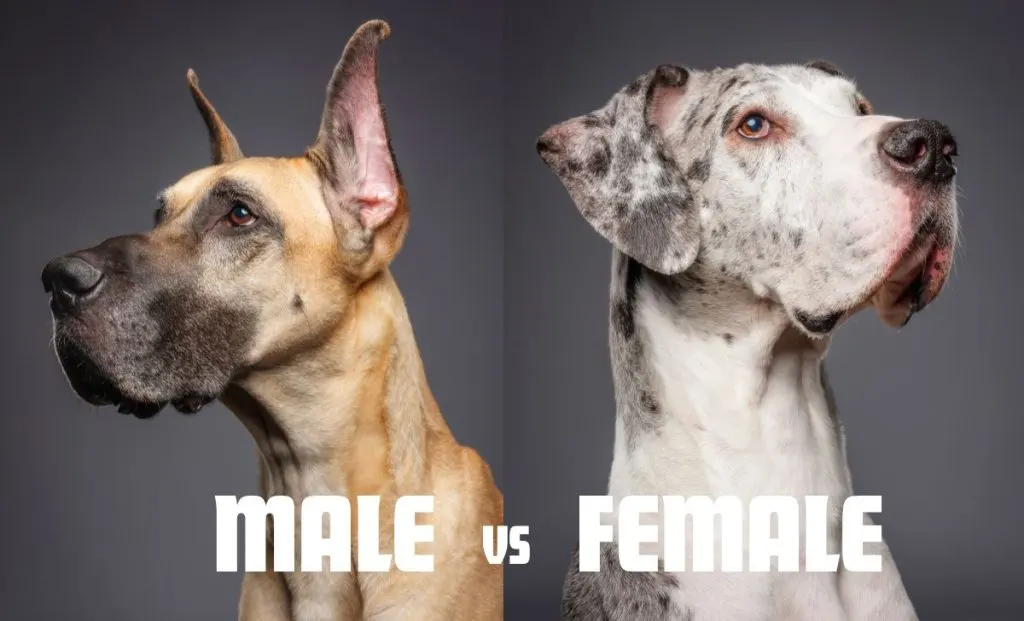
Great Danes are a breed with unique eating requirements that must be met for them to grow and stay healthy.
The physical size, rate of growth, and physiological differences between male and female Great Danes cause their dietary needs to vary.
An understanding of these variations is vital in promoting well-being and long life in your adorable furry buddy.
Differences In Size And Rate Of Growth
In general, males are much bigger than females among Great Danes.
Typically, an adult male will weigh between 140 and 175 pounds while standing at a shoulder height of 30 to 34 inches (76 to 86 cm).
On the other hand, adult females usually weigh around 110 -140 lbs and are 28 to 32 inches (71-81cm) tall.
Such great disparity in size means that males require more calories than their counterparts to maintain high energy levels and muscle mass.
Compared to their female counterparts, males grow faster and continue growing for longer periods.
This rapid growth phase calls for extra care so that they don’t overgrow, which could lead to problems like hip dysplasia or joint problems.
Different Nutritional Requirements
- Caloric Needs: Male Great Danes require more calories than females due to their larger bodies and higher amounts of muscle. For instance, an active adult male may need about 2500 – 3000 kcal daily, whereas an active female could be fine with just around 2000 – 2500 kcal daily.
- Protein and Fat: Both sexes need high-quality proteins that support muscle formation, but males should consume slightly more because they have bigger muscles. Fats provide essential energy; therefore, while overall fat intake remains similar, the total quantity might be higher among males due to increased caloric demands by exercise and similar factors.
- Vitamins and Minerals: Balanced vitamins and minerals, especially calcium and phosphorus, are important for both sexes as they help promote bone health and avert developmental problems. The ratios must be controlled well to avoid issues like hip dysplasia.
Understanding Great Dane Nutrition

Great Danes are one of the largest dog breeds, and their rapid growth can be both fun and scary to watch.
Proper nutrition plays a big role in preventing health issues like growth diseases, keeping a good weight on the dog, and ensuring overall well-being.
The Puppy Stage – Weeks of Age and Nutritional Needs
After the best day of your life (bringing your new puppy home), the next important step is to provide a nutrient-dense diet to support the rapid growth that the breed is known for.
In the first few weeks of age, Great Dane puppies grow awfully fast, so their diet must be rich in proteins and balanced nutrients to support their bodies through that phase.
During this period, feeding them the right line of foods can set the foundation for a healthy life, like developing strong bones and muscles without the risk of growth diseases.
New puppy owners should focus on providing high-quality puppy diets that are specifically formulated for giant puppies.
Feeding Schedule and Portions
A consistent feeding schedule is one of the most important factors for developing good eating habits in your Great Dane puppy.
An important note to remember is that they should be fed 3 to 4 times a day in small amounts. This helps prevent bloat, a common and serious condition in giant puppies. Ensuring that your puppy doesn’t eat too much food at once is crucial.
For example, at eight weeks, a puppy might need about 1,500 to 2,000 calories per day, divided into four meals.
By three months, their caloric intake increases, and so does the quantity of food. At this stage, a good weight for your puppy is around 25 to 45 pounds, depending on their growth patterns.
As your puppy grows, it’s essential to maintain a consistent feeding schedule to support their rapid growth and high energy needs at the given month.
But here is a general guideline you can look through to check if your puppy’s food consumption is on the right level.
From birth to about three weeks, puppies should be nursed by their mother. Around 3 to 4 weeks, they can start on a high-quality puppy gruel or soft food, gradually transitioning to solid food by 6 to 8 weeks. At this stage, they should be fed four meals a day.
From 8 weeks to 3 months, the puppy will need 2 to 3 cups of food daily, divided into three meals. From 3 to 6 months, increase the amount to 3 to 5 cups per day, also split into three meals.
From 6 to 12 months, the puppy will eat 5 to 8 cups daily, divided into two or three meals.
The exact amount depends on the puppy’s weight, activity level, and growth rate.
But let us examine things in detail.
Transitioning to Adolescent Diets
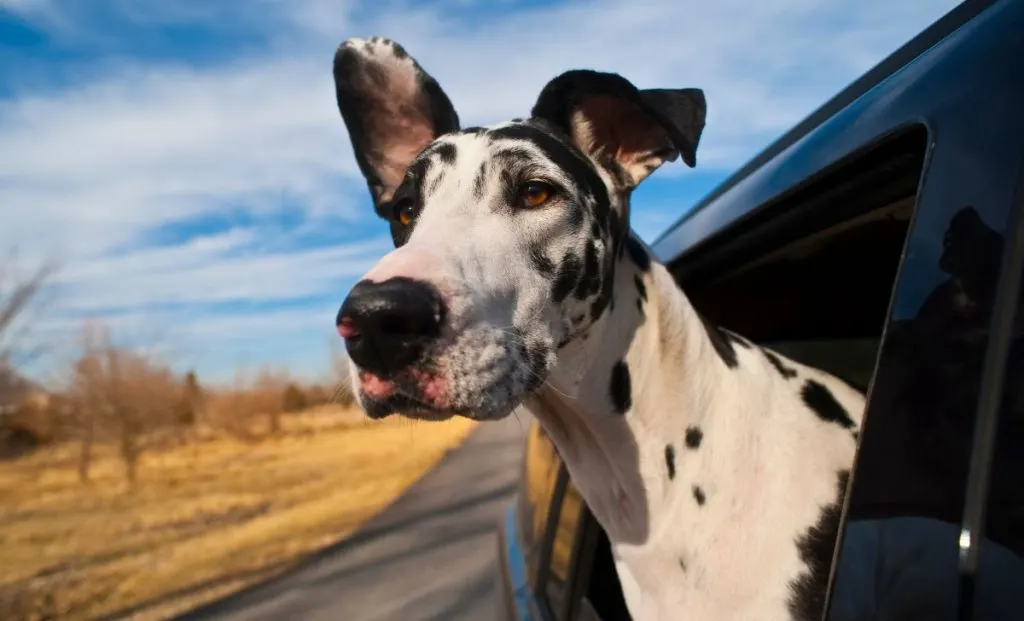
As your puppy grows, around six months, you will notice significant changes. This is the most sensitive time for their development, and their dietary needs will change accordingly.
They will require a feeding transition to ensure they continue to get the right amount of nutrients.
Portion Adjustments
During this adolescent stage, it’s essential to adjust the portions and types of food. A high-quality large-breed puppy formula should still be used but in larger quantities.
For instance, a six-month-old Dane might need around 2,000 to 3,000 calories per day.
Monitoring their growth patterns and ensuring they are gaining weight appropriately is key.
Exercise and Its Impact on Feeding
Free exercise in good weather is perfect for building their muscles and ensuring they maintain a healthy weight.
However, extreme exercise should be avoided as it can stress the developing joints.
Remember, your growing Dane has specific requirements, and a balance of nutrition and moderate exercise is essential.
Adulthood – Balancing Nutrition and Activity
By the time your Great Dane reaches adulthood, their dietary needs will stabilize.
An adult Great Dane typically needs around 2,500 to 3,500 calories per day, depending on their activity level.
At this stage, their food should be less calorie-dense than puppy food to prevent obesity, especially since they may engage in less exercise compared to their younger days.
Daily Feeding Routine
Establishing a consistent feeding routine is crucial. Two meals per day are generally sufficient for adult Great Danes.
Choose high-quality dry food that is specially formulated for large breeds to support their joint health and overall well-being.
If your Dane is a good eater but tends to gain weight easily, you might need to adjust their portions accordingly since you might be providing a too high amount of food and not as much exercise as you should.
Older Danes – Adjusting to New Needs
As Great Danes age, their activity levels decrease, and so do their caloric needs.
An old female Dane, for example, might require food that is easier to digest and lower in calories.
Ensuring they receive the necessary nutrients without overfeeding is crucial to prevent health issues.
Senior Diet Adjustments
For senior Great Danes, maintaining their weight and health becomes more challenging. Typically, they need around 2,000 to 2,500 calories per day.
At this stage, it’s important to provide them with senior-specific food that supports their joints and overall health.
Smaller, more frequent meals might be beneficial to avoid digestive issues and ensure they get all the nutrients they need.
Common Health Issues and Nutritional Management
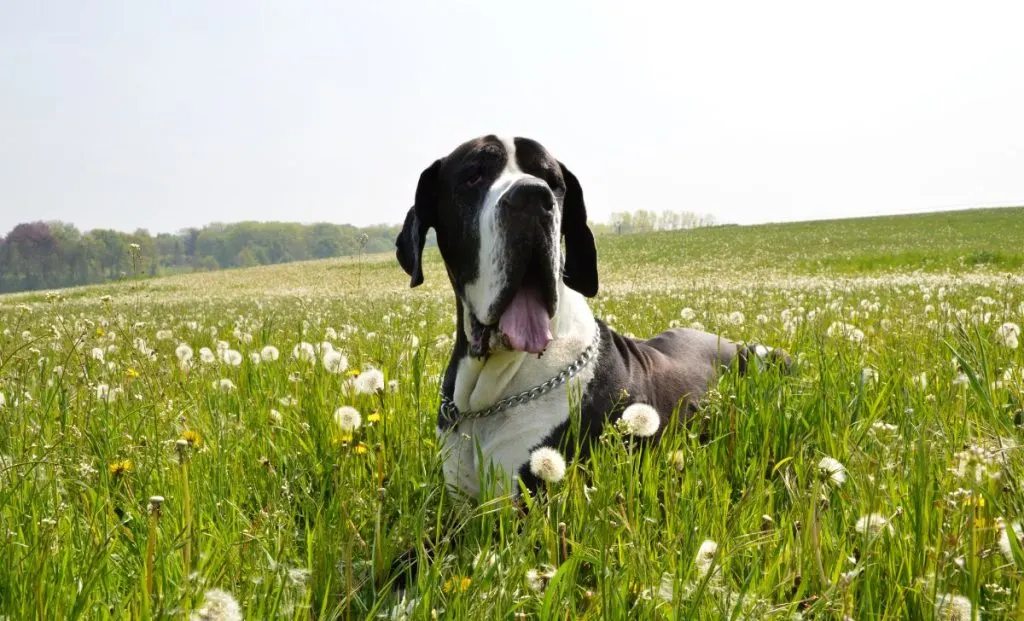
- Hip Dysplasia: a hereditary condition in which the hip joint does not form properly, leading to arthritis. Balanced diets should include glucosamine and chondroitin, known for improving mobility among canines with this problem.
- Dilated Cardiomyopathy (DCM): This heart ailment occurs when muscles weaken or enlarge, causing blood to circulate throughout the body. Certain omega-three fatty acids, together with taurine, help support cardiac healing, but regular vet check-ups aid in early diagnosis and control measures.
- Gastric Torsion (Bloat): Life-life-threatening condition common among large breeds; feed smaller quantities regularly, avoid exercising before/after meals, and use slow feeders
- Wobbler Syndrome: A condition that affects the spinal cord and neck neurologically. This can be reduced by ensuring moderate and steady growth through a balanced diet during their puppyhood.
Food Allergies in Great Danes
Food allergies can affect Great Danes just like any other breed.
This occurs when the immune system mistakenly recognizes certain diet components as harmful, leading to an allergic reaction associated with signs such as skin problems, gastrointestinal upsets, or even respiratory difficulties.
Thus, appropriate control measures are necessitated for maintaining good health among these giant dogs.
Symptoms of Food Allergy
The commonest clinical signs observed during allergic responses include itching around the face/head region, mainly affecting ears/muzzle areas.
Followed by redness/hives appearing on belly/limbs, particularly feet/paws; there may be digestive disturbances manifested by vomiting, diarrhea and flatulence while some animals exhibit respiratory signs like sneezing fits, coughing episodes and or shortness of breath.
Therefore, a veterinarian must be consulted to differentiate these symptoms accurately from other medical conditions.
Major Food Allergens
Among the most frequently reported protein sources causing hypersensitivity reactions in GD are beef meat, chicken flesh, lamb meat, fish filets, and milk products such as cheese/milk/yogurt, which can cause allergies.
Moreover, grains like wheat flour, corn syrup, or soybeans may act as allergenic substances with artificial additives (preservatives/colors/flavors) commonly used in commercial pet foods.
Diagnosis and Therapy

To establish the presence of food allergy elimination diet trials should be conducted whereby an animal is fed on a novel ingredient list for around 8-12 weeks, i.e., none of the known allergenic proteins are included in its composition.
In cases where improvement is seen during this period, the dog has a dietary sensitivity problem.
The next step involves a gradual reintroduction process where each potential allergen gets added back one at a time until the culprit agent is identified.
After knowing what causes allergic reactions, avoidance becomes the mainstay treatment method; hence, special diets like those having rare types of meat.
For example venison/duck or hydrolyzed proteins consisting of smaller peptides could be prescribed since they have reduced immunogenicity potentials, thus lowering risks associated with such events.
Dealing With Food Allergies
Effectively dealing with food allergies involves some steps. One of them is to read ingredients of commercial dog foods and treats carefully so as not to contain the allergen.
This implies frequent veterinary check-ups to monitor a dog’s health condition and adjust its diet accordingly. Additionally, it’s advisable not to feed a Great Dane table scraps, since human food may have hidden allergens.
Another method for managing food allergies is by keeping a consistent diet plan. Changing what your pet eats frequently makes it difficult for you to know what causes an allergic reaction; thus, this should be avoided.
Also, when introducing new types of treats, one must do it slowly while ensuring they are hypoallergenic and do not contain common allergens.
Moreover, supplements like omega-3 fatty acids can also be taken, which improve skin health and reduce inflammation, thereby relieving more symptoms associated with allergy relief.
How To Change The Food Brand I Feed
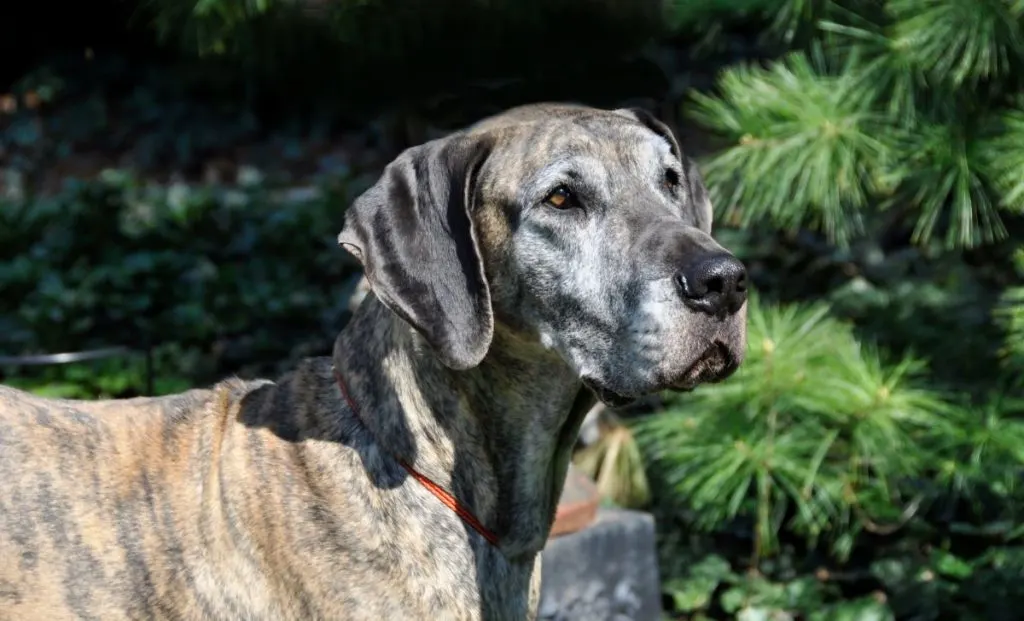
Switching over a Great Dane’s food gradually is advisable to prevent digestive problems.
Begin by selecting a time when your dog is healthy and not stressed out due to other changes, such as moving into new homes or recovering from illnesses.
Allow for a slow transition period lasting between seven and ten days, thus enabling your pet’s digestive system to become accustomed to the novel diet.
For the first two days, mix 25% of the new food with 75% of the old food; during the third & fourth days, mix 50% each (new vs. old for the day total).
Then, on the fifth through sixth days, feed three-quarters (3/4) portions between the two products.
From the seventh day onwards, serve only the new brands/flavors without mixing it with the old one.
Throughout this change, keep an eye on how well they respond since some may experience upset stomachs indicated by vomiting, watery stool, or lack of appetite.
This requires slowing down the introduction process, giving them a longer period of adjusting to the new ratio fed.
Keep feeding times the same. Avoid introducing new treats/supplements throughout this phase because consistency reduces further strain on the animal’s digestion system during such adjustments.
Remember to provide plenty of clean drinking water, as adequate hydration plays a crucial role, particularly during a shift from one type of meal plan to another.
How Often Should I Feed My Great Dane
Great Danes should be fed two to three times daily to prevent bloat, a serious and potentially fatal condition common in large breeds, and to maintain steady energy levels.
Feeding smaller, more frequent meals helps reduce the risk of bloat by preventing the stomach from becoming too full at once.
For puppies, feeding them three to four times a day is advisable due to their rapid growth and higher energy needs.
This frequent feeding schedule supports their metabolism and ensures they get the nutrients required for healthy development. Gradually, as they grow older, you can transition to two to three meals a day.
What Should I Avoid Feeding My Great Dane
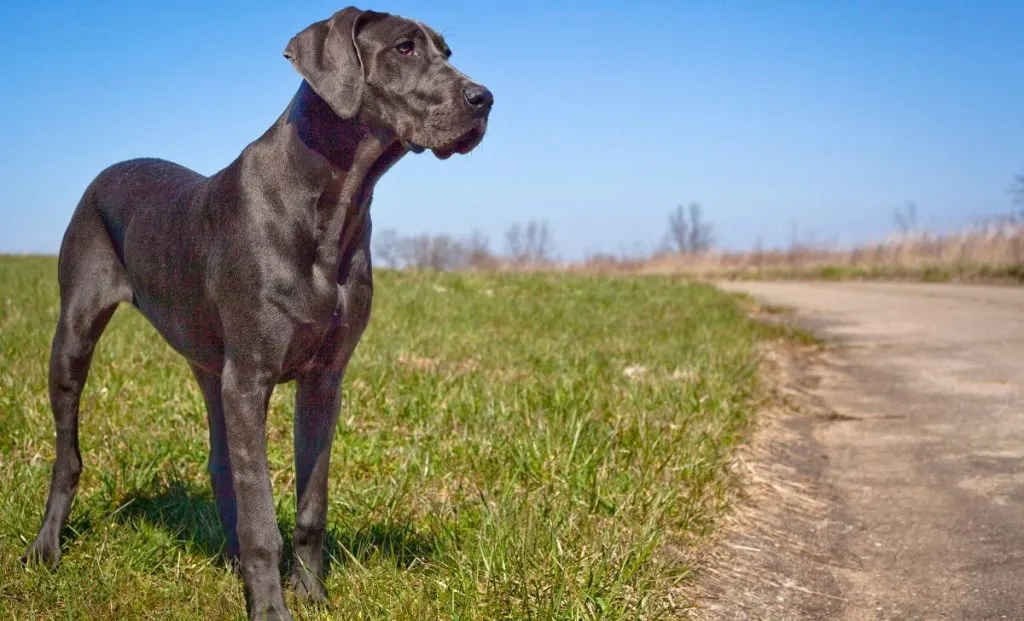
Great Danes should not be fed human foods that are toxic to dogs, including chocolate, grapes, raisins, onions, and garlic, as these can cause serious health issues.
Chocolate contains theobromine, which is toxic to dogs, while grapes and raisins can cause kidney failure.
Onions and garlic can lead to gastrointestinal irritation and damage to red blood cells. Additionally, avoid low-quality dog foods that contain fillers such as corn, soy, and wheat, as well as artificial additives, preservatives, and colors.
These ingredients provide little nutritional value and can contribute to allergies and digestive problems.
Instead, choose high-quality dog food that lists meat as the first ingredient and includes wholesome grains, fruits, and vegetables.
Can I Feed My Great Dane A Raw Diet
Feeding your Great Dane a raw diet can be an option, but it requires careful planning and consultation with a veterinary nutritionist to ensure it is balanced and meets all their nutritional needs.
A raw diet typically consists of raw meat, bones, vegetables, and supplements. It is essential to ensure that the diet contains the correct proportions of protein, fat, vitamins, and minerals to prevent deficiencies and health issues.
Raw feeding isn’t as simple as giving your dog large chunks of meat or table scraps.
Improperly balanced diets can lead to nutritional imbalances, causing problems such as skeletal deformities in puppies or other health issues in adults.
Hygiene is also crucial when handling raw food to avoid bacterial contamination.
How Can I Tell if My Great Dane is Overweight
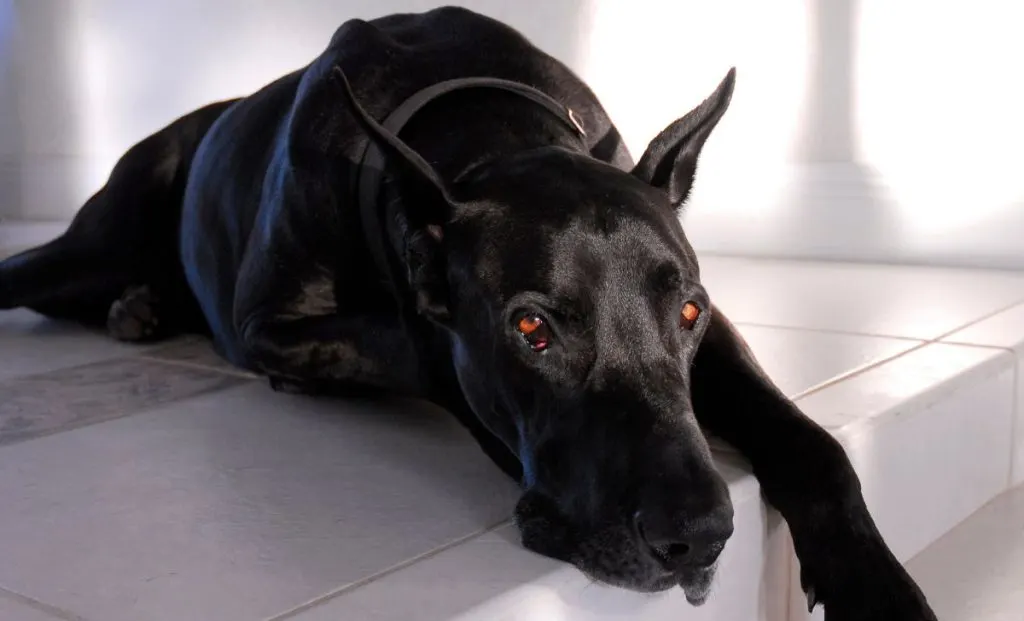
Regularly checking your Great Dane’s body condition score (BCS) is essential for maintaining their health.
To do this, run your hands along their sides; you should be able to feel their ribs without excess fat covering them.
There should also be a visible waist when viewed from above and a tuck in the abdomen when viewed from the side. If you cannot feel the ribs easily or if their waist and abdominal tuck are not noticeable, your dog may be overweight.
Overweight Great Danes are at higher risk for joint problems, heart disease, and other health issues.
Monitoring their food intake, including the number of treats given daily, and ensuring they get regular exercise can help manage their weight.
If you are unsure, consult your veterinarian for a professional assessment and guidance on maintaining a healthy weight for your Great Dane.
To Sum It All Up
Feeding your Great Dane according to their life stage is crucial for their health and longevity.
From the rapid growth of puppyhood to the slower pace of their senior years, each stage requires specific dietary adjustments.
By following this feeding chart and consulting with your veterinarian, you can ensure that your gentle giant remains healthy and happy throughout their life. These dogs will take up much energy, time, and space but will definitely return the favor.
Remember, every Great Dane is unique, and their dietary needs may vary based on their health, activity level, and individual preferences.
By providing the right food in the right amounts, you can help your Great Dane live a long, healthy, and fulfilling life.

Nandina has been a lifelong dog owner and enthusiast. She shared her home with multiple breeds, including Giant Schnauzers, Cane Corsos, and Huskies. Currently, she is raising a three-year-old rescue and a working-line German Shepherd puppy.
Actively engaged in IGP dog sports for two years, Nandina is a certified instructor for basic obedience and socialization. She works as a trainer in her local dog sports club, and in her spare time, she handicrafts biothane gear for dogs.
